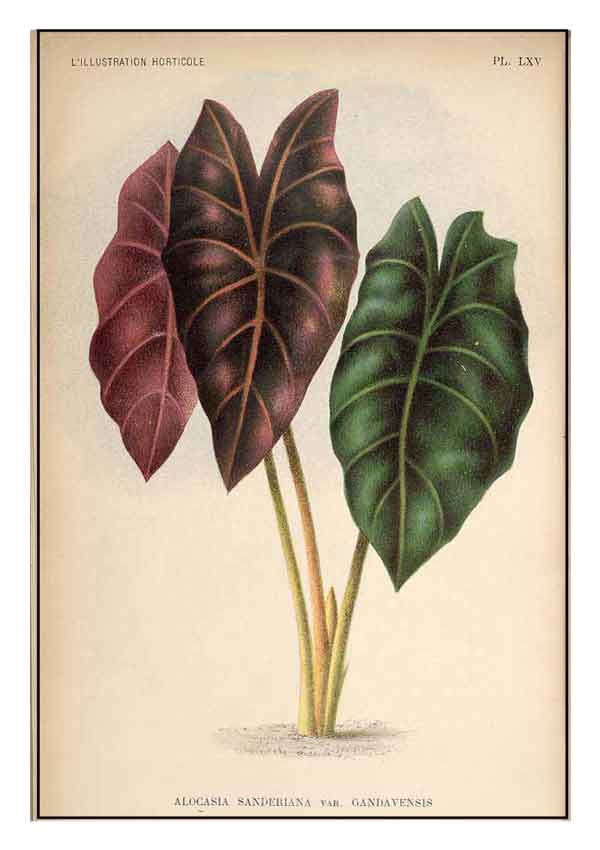 Gen info Gen info
- The name Kris Plant refers to the resemblance of the leaf edges to the wavy blade of the kalis dagger. (4)
- Alocasia genus consists of about 79 species of which 28 are cultivated varieties.
Botany
Alocasia sanderiana is a robust tropical perennial growing ta a height of about 6 ft (2 m). Leaves are deep green, glossy, pelted, V-shaped, wavy margins, and deeply lobed, with large, silvery, white veins,12 30-40 cm long and 15-20 cm wide, with red-green undersides. Leaf stem is about 60 cm long. Rhizome or root stock is vertically placed. Female flowers grouped at the lower part of the inflorescence, while the male flowers are at the top. Cultivated specimens are smaller. (4)
A. sanderiana is a moderately robust herb growing up to 60 cm tall, decumbent to creeping, about 15 cm long, 2 cm thick. Leaves solitary to few together, interspersed with cataphylls. Cataphylls papery, narrowly lanceolate; petiole up to 60 cm long, sheathing in lower fifth to quarter; blade sagittate, deep glossy green adaxially, purple abaxially, peltate for 25-30% of the length of the posterior lobes 40 cm long by 20 cm wide; margin deeply undulate to sub-pinnatifid; anterior lobe to 24 cm long; anterior costa with 3-4 usually opposite primary lateral veins on each side diverging at about 80-100°, somewhat acropetally deflected towards the tip of each segment; primary veins and costae white to yellowish; secondary veins emerging from the primary at a wide angle, deflected marginally. Inflorescence mostly paired; peduncle slender, 14-18 cm long; spathe 6-10 cm long; lower part 1.5-2 cm long; ovaries 2 cm diameter, subglobose; stigma sessile, sharply 3- to 4-lobed; sterile interstice corresponding to spathe constriction, 5 mm long, tapering distally; synandria rhombo-hexagonal; synconnective centrally impressed, marginally slightly exceeding but not capping the thecae; appendix short, equaling the male zone, cylindric then abruptly tapering in distal 3-4 mm, slightly narrower than the male zone. (2)
 Distribution Distribution
- Native to the Philippines.
-
Reported endemic to Mindanao (Missamis Occidental and Bukidnon).
- Introduced to the Cook Is.
- Also reported in India.
- Classified as critically endangered by the International Union for Conservation of Nature (IUCN). (1)
Constituents
- Phytochemical screening of various leaf extracts yielded triterpenes, tannins and saponins. (see study below) (3)
- Phytochemical screening of leaf, stem. and root ethanolic extracts yielded tannins, glycosides, saponins, terpenes, flavonoids, carbohydrates, steroids, proteins, phenols, with absence of amino acids.
Only the root yielded alkaloids. Leaf extracts were strongly positive (+++) for tannins flavonoids, steroids, and phenols, and moderately positive (++) for gkycosides. (see study below) (4)
- Analytical study
showed total ash value of 3.30% w/w in in the ethanolic root tuber extract. Weight loss on drying on moisture contents of ethanolic leaf, stem and root tubers were 63.69, 73.35, and 75.63%, respectively. The amount of acid-insoluble siliceous matter in tuber extracts was 0.95 w/w%. The ethanolic root tuber extract showed higher value of water soluble extractive values. (5)
Properties
- Studies have suggested antioxidant and antibacterial properties.
Parts used
Leaves.
Uses
Folkloric
- Leaves used for toothache by the Matigsalug tribe of Marilog district, Davao City. (6)
-
In Thailand, roots used to treat impotence and increase sexual desire.
Others
- Ornamental: Cultivated as an ornamental plant for its large, dramatic foliage.
Studies
• Non-Active Antimicrobial / Leaves: Study evaluated the antimicrobial property of various solvent extracts of Alocasia sanderiana leaves against 18 strains of organisms. No significant zone of inhibition was achieved. (3)
• Antioxidant / Antimicrobial / Leaves, Stems and Root Tubers: Study evaluated the antioxidant and antimicrobial activities of ethanolic leaf,stem, and root tuber extracts of A. sanderiana. Antimicrobial activity was assessed by disc diffusion method against five clinically bacteria viz. S. aureus, E. coli, K. pneumonia, P. aeruginosa, and B. cereus and five fungi viz. F. solani, A. fumigatus, A terreus, R, oryzae, and C. albicans, with gentamicin and ketoconazole as standards. Results showed significant antibacterial activity with stem showing more activity than the leaf and root. In the antifungal study, stem and root tubers showed more inhibition than the leaf. Among the samples, the leaf showed more potent antioxidant activity on DPPH and ABTS assays than stem and root extracts. (see constituents above) (4)
Availability
Wild-crafted. |

![]()




 Distribution
Distribution